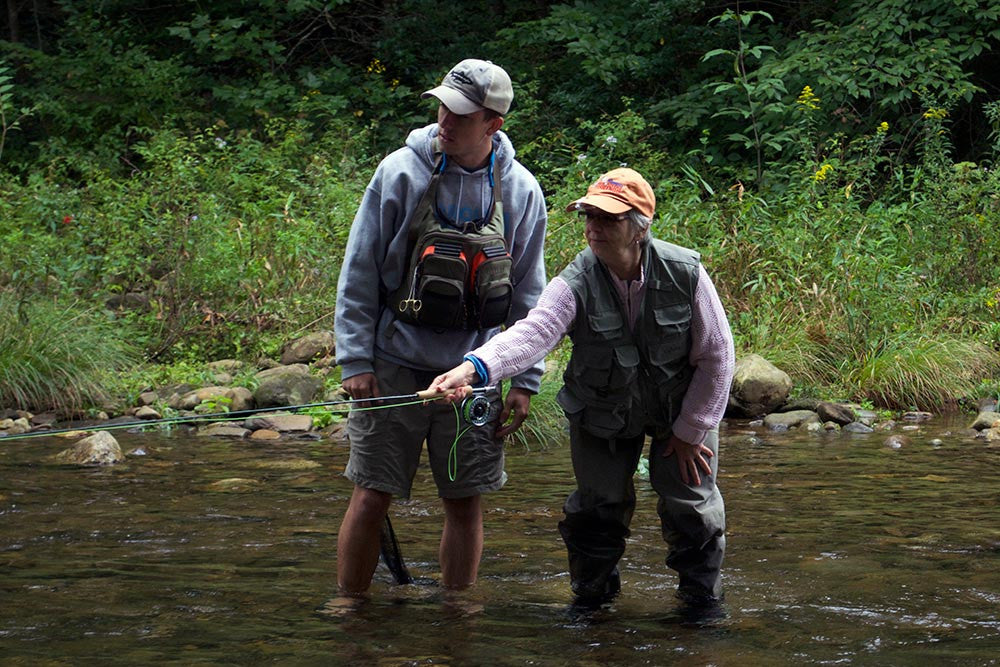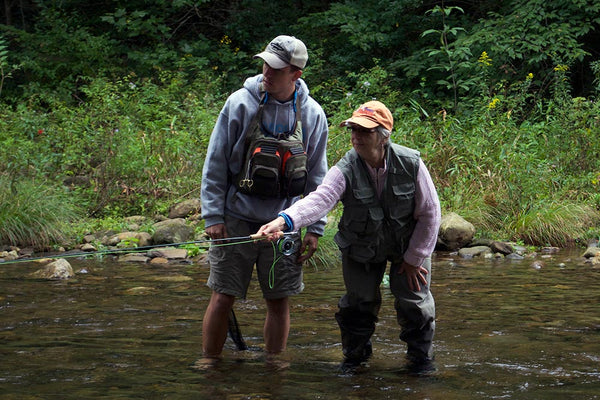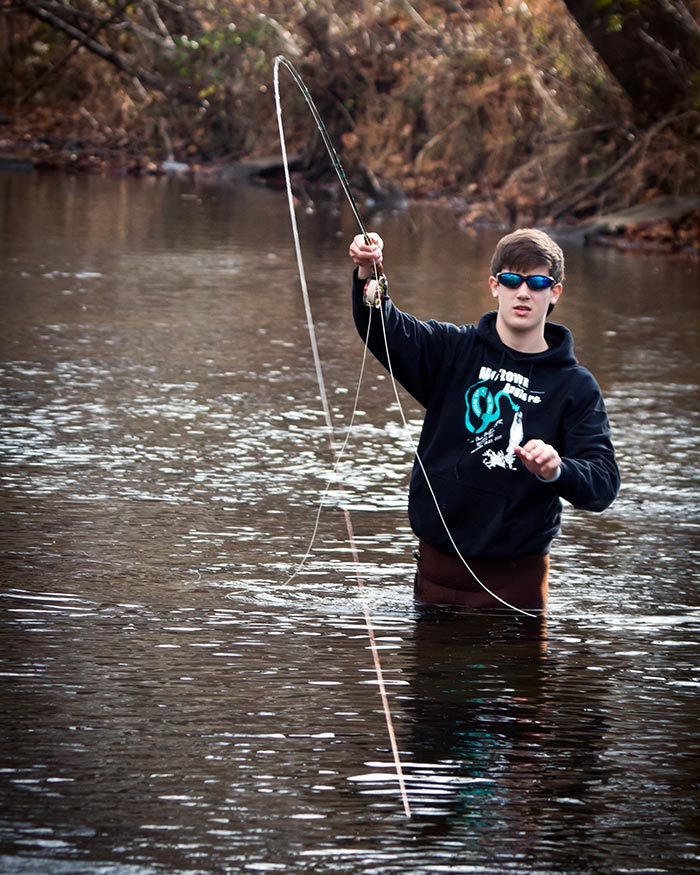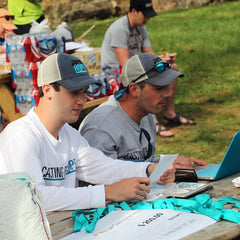They're at Your Feet, Dude! 6 Reasons To Make Shorter Casts When Wade Fishing


Volunteer guide Jeff Konst teaching a Casting For Hope retreat participant to fish inside the rod length.
My Favorite River in the Whole World Is the South Holston Near Bluff City, Tennessee
The sulphur hatches in the late spring, summer, and early fall are so dependable that on high water, I can often set my watch for 2:30 by the first bug I see escaping the water’s surface. The popping of big fish heads commences soon after—as does the hero casting!
Recently, a younger fishing buddy of mine named Cam and I had dragged my Hyde drift boat down to a favored wading spot on the SoHo on the low water while we waited on the afternoon generation release to take a long and productive float. Predictably, there was a slew of other anglers hero casting across the river, attempting to score a few more fish before the water hit.
Fish were rising up and down the river, munching on yellow bugs as far as I could see in every direction. And fish were rising within ten feet of every single angler I saw, but instead of smart, productive fishing, I saw one 60- to 80-foot cast after another.
As I usually do, I saw only a few fish hooked that weren’t attached to the end of my or Cam’s leaders. The frustrated looks of those around us that begged “what are you doing differently” became palpable—and once audible.
The difference in our productivity was that we didn’t feel the need to show off our casting abilities (and I can cast and Cam can cast better than I can!). We instead picked fish off close to us and then moved closer to the fish further away, picking them off one by one.
There are times when we do need to reach out to a fly line’s distance to hit fish (i.e., when there’s a brute fish feeding consistently 90 feet away but there’s no way to move the boat to get to him without losing too much ground). But wade fishing rarely presents those needs.
Here are six cumulative reasons to stop casting so dang far!
1. “They’re at Your Feet, Dude.”

Squeak Smith demonstrating quiet wading and short casting.
I think we often make fly fishing a whole lot harder than we need to. Maybe it’s good for our egos to pick off a fish eating at 70 feet away from us, but I prefer to catch fish than cast.
And fish are often right at our feet.
If you can wade quietly, there’s usually no need to cast across the river to catch fish. I usually tell first-time clients on the way to the river that they "need to forget everything they’ve ever seen or heard about fly fishing. We’re not going to try to emulate Brad Pitt in A River Runs Through It. We don’t catch fish casting… We catch fish fishing.”
3 Articulated Streamer Fly Styles That Simply Get ‘er Done
Fishing close in and working your way out, often by physically moving your locations, increases productivity substantially and the next points demonstrate why you need to catch the fish at your feet first!
2. You Won’t Spoil the Rest of the Fishing

John Zimmerman with a big brown caught within rod tip length.
Targeting feeding fish closer in creates a fishing space in which you’re not spoiling the fishing between you and the fish that are 60 to 80 feet away.
Errant deliveries, splashing line down, otherwise misdirected casts and dragging line over the fish between you and fish you’ve targeted 60-80 feet away only serves to put the fish right in front of you down.
Take Your Baby Fly Fishing: 5 Tips for Fishing With an Infant
Be patient. Catch those fish close first. The fish you saw 60 feet away aren’t going anywhere. But if you keep casting over and over the fish right in front of you, you might just put those guys down for good.
3. Better Presentations
Targeting feeding fish closer to you allows you to make much more precise casts and nail the targeted fish more quickly.
We don’t want to give the fish we’re targeting too many opportunities to check out our flies before we put them in the right place to initiate an eat. Too many “close but not close enough” casts to that fish and he’s going to clue in and say, “mmm…not today. Should've made a better first cast if you wanted to fool me.”
The Dark Side… Night Fishing for Big Brown Trout
I can’t describe the number of times I’ve had to say to a client, “Well, if you’d made that cast the first time, he’d have eaten.”
Getting the right cast closer in is much easier than long distance presentations.
4. Improved Mending
Catching those fish 60-80 feet away depends more on the mend than the cast!
Even if you can cast 60-80 feet in your front yard, that doesn’t mean you can catch fish 60-80 feet away from you in the river.
The farther your target is away from you on real water…the more demanding and tougher the mending process is going to be. Mending well close to you is so much more easily accomplished than mending well far away.
3 Tips To Improve Your Streamer Fly Fishing
Even if you can make the 60- to 80-foot casts with accuracy, if you can’t get a good enough mend on that cast, you’re not going to catch the target fish and you’re going to drag line over all of the fish between you and him and risk putting all of those fish down.
5. Physics Are on Your Side for the Hook Set

Taylor Sharp of Upper Creek Angler and Casting For Hope demonstrating quick hookups with short casts.
Hook setting at 80 feet—that’s tough boys and girls.
Even if you’re a good enough caster and mender to get a fish to eat your flies at 60-80 feet away, hooking that fish is a totally different story.
Why Is My Baitfish Pattern Swimming Wrong? Part 2
Just think about the physics behind this problem. Before you can hook a fish, you’ve got to tighten every inch of fly line and leader between you and the fish. Getting tight enough between you and a fish that far away to drive a hook point in before he’s had a chance to spit the bug…that’s tough! It’s tougher than casting 60-80 feet—and it’s tougher than mending 60-80 feet of line.
As you can see, this is a cumulative process. Each step in hooking up with a fish that far away from you is harder than the step before.
6. Landing the Fish

Taylor finishing up his demonstration with a quick landing.
But let’s say that you can make the long-distance cast, get the mend necessary to get an eat, and even consistently get a hook set from that far away…
Now what?!
To land that fish, you’re going to have to recover all of that line before he ties you around a sunken log, lodges himself under a rock, saws you off on a series of ledges or just spits—all of which has happened to me and others I know too many times to count.
Trout Fly Fishing: 3 Bad Habits to Break
And if you do manage to land him, you’re going to have to bring him to you thrashing about, attempting to run up and down the river in every direction except a straight line toward you.
If my friend had a hook in his face and was being dragged 80 feet from his home right in front of mine, I’d probably stop eating for a while! And I’ve watched it happen over and over and over. Those fish between an angler and his long-distance target shut down for at least a while after the angler drags a hooked fish through their feeding lanes (remember point 2 - you don't want to spoil the rest of the fishing).
Quick Review
It just makes sense to fish to the fish closest to you and move out to the fish farther away.
Do this and your productivity in every direction will go up!
You’ll get more eats; you’ll get more hook ups; you’ll land more fish; and after you’ve landed a fish, you’ll still have fish right in front of you ready to catch!
Want More Articles Like This?
Subscribe to the Flymen Newsletter at the Bottom of the Page!
About John Zimmerman:
 With Taylor Sharp (pictured left), John Zimmerman (right) is co-owner of Upper Creek Angler and co-founder and Chairman of the Board of directors of Casting for Hope. Upper Creek Angler is a guide and custom-built fly-rod service based in Morganton, NC. Casting for Hope is a regional nonprofit that serves women and families in Western North Carolina following a diagnosis of ovarian or other gynecological cancer through financial assistance and retreat programs. Casting for Hope’s flagship fundraiser is the only official Trout Legend Gold-Level fly-fishing competition on the east coast and one of just three in the United States. Watch the brief video below to learn more about Casting for Hope and the work John, Taylor, and their team are doing in WNC for women and families affected by ovarian and other gynecological cancers.
With Taylor Sharp (pictured left), John Zimmerman (right) is co-owner of Upper Creek Angler and co-founder and Chairman of the Board of directors of Casting for Hope. Upper Creek Angler is a guide and custom-built fly-rod service based in Morganton, NC. Casting for Hope is a regional nonprofit that serves women and families in Western North Carolina following a diagnosis of ovarian or other gynecological cancer through financial assistance and retreat programs. Casting for Hope’s flagship fundraiser is the only official Trout Legend Gold-Level fly-fishing competition on the east coast and one of just three in the United States. Watch the brief video below to learn more about Casting for Hope and the work John, Taylor, and their team are doing in WNC for women and families affected by ovarian and other gynecological cancers.


Your “casting for hope” story is inspirational. I’ve been teaching fly tying and short line fly fishing to some intellectually disabled adults where I am on staff. Some are able to wade in beside me. For those who can’t, we have spin cast set ups that allows them to drift their fly under a weighted indicator. Watching these individuals catch fish on flies they themselves tied is probably my greatest fish story.
well done john! how often is the obvious overlooked…there is no one more foolish than the fisherman.
Dean, You should definitely not worry about developing an inferiority complex. There is no correlation between distance-casting ability and fish-catching skill. Were you to come watch a Casting for Hope fishing competition, you’d watch some of the best anglers in the country and they’d be fishing within the lengths of their rods!
George, I totally agree! There’s been some real monkey business with rod development and line development to coincide. Those super fast rods are terrible fish fighting tools. And if you’ve been watching the market, we’ve been developing heavier and heavier lines without changing the advertised weight—why? Because we’ve had to in order to tame some of these super fast rods. I’m so happy to see a resurgence of slower and more fully-flexing rods back on the market.
Sam, I’d be more than happy for you to share these points I’ve made in your upcoming newsletter. Just cite these awesome folks at Flymen as the source material.
Issac, I don’t have any tenkara rods. But…the rods I pull from the stacks most often are 10’-11’ fully-flexing 2-3 weights…so I very often fish in a makeshift tenkara style without being limited to strictly tenkara if I need to stretch out a bit.
Tight lines!
John
It sounds like you’d really like Tenkara. Have you tried it yet?
John,
Great points in your article. I was wondering if you would allow me to share these points in our local Erie, Pa Steelhead Association newsletter. I see this happening all the time on our local streams and I am always looking for bits of info to educate our members and readers of our newsletter “Tightlines”.
Sincerely,
Sam Zacour
TightLines editor
PA Steelhead Association
Leave a comment